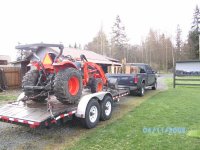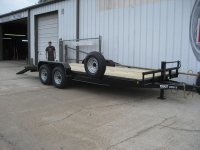As far as wd hitches, I've always thought of them as a way to stretch a trailer/tow vehicle slightly beyond their design limits. If you NEED one, you should have bought/borrowed a bigger trailer/truck or found a better way to position your load.
Pat, with all due respect, you couldn't be more wrong here. WD hitches don't "stretch" your vehicle's capacity. They allow your vehicle to achieve its full capacity. The limiting factor on most bumper-pull vehicles' towing capacity is the hitch's rating. Most hitches have a significantly higher rating when used with a WD system than without. Without a WD system, you'll typically see a rated tongue weight as low as 350 lbs; more typically around 500-1000 lbs; and very, very rarely up to 1500 lbs. With a WD system, the rated tongue weight usually goes up into the 1-1.5k range. The reasons for this are myriad, but one of them that is commonly overlooked is how the weight of the trailer is distributed across the bolts holding the hitch onto the vehicle's frame. Without a WD system, all of the weight is on the rear-most bolts, which are acting as a fulcrum. The front-most bolts are actually being pushed upwards. Once you add the torsion of a WD system, the weight of the trailer is more evenly distributed across the bolts holding the hitch on.
There are exceptions to these statements. For example, some factory hitches are welded onto the frame (Toyota Tundra does this) and achieve full rated capacity without a WD system. Some aftermarket hitches are just engineered to work without a WD system, and achieve full rated capacity without one. Also, some vehicles, like cars and small SUVs, don't have much capacity either with or without a WD system, so it might make sense to say that the WD system "stretches" the capacity.
But it's never true to say that a WD system is stretching a vehicle beyond its design limits. The WD system is part of the design limits of the towing system. If you NEED one, it simply means you want to tow more than your vehicle is rated to tow without a WD system, but less than your vehicle is rated to tow with a WD system.
It's true that a WD system can save you some hassle in positioning your load. If your hitch is rated 500 lbs tongue weight (TW) without a WD system and 1000 lbs TW with a WD system, you can afford to be 500 lbs more careless in front-loading your trailer if you have a WD system. Woo hoo! But you still must always have at least 10% of the trailer's weight on the tongue, or you're likely to have problems keeping the trailer behind the vehicle. You can get away with a tail-heavy trailer if your tow vehicle is sufficiently heavy relative to your trailer, but it doesn't take much to get the "tail wagging the dog," so to speak.

![newtrailerpics004[1].jpg newtrailerpics004[1].jpg](https://www.tractorbynet.com/forums/data/attachments/236/236447-7fa543acbdcbe528512ead70af1be6da.jpg)
